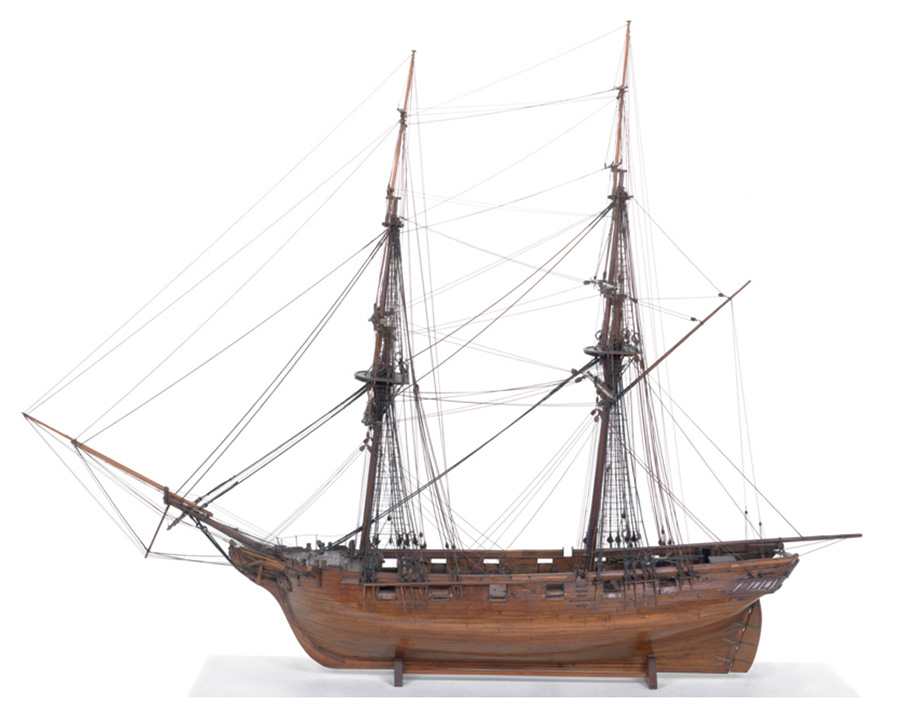HMS Jasper
The Jasper was a Cherokee Class brig-sloop, a sloop with two masts, which carried eight 18pdr carronades and two 6pdr long guns. This class of ship was designed to be the smallest viable ocean-going warship. This type of vessel, alongside the Cadmus and Rolla classes, earned themselves the unfortunate nickname of 'coffin brigs' for their propensity to wrecking or foundering; nearly a quarter of the type were lost of the 100 or so built. The most famous 'coffin brig' was HMS Beagle on which the naturalist Charles Darwin sailed. Jasper's keel was laid down in February 1808 at Ipswich under Jabez Bailey, the 90ft brig-sloop was launched in May and commissioned under Cdr. William David a month later.
Jasper was used for convoy escort duty up until July 1816 when she sailed as a part of a fleet of 19 vessels bound for Gibraltar and the Bay of Algiers, before returning in August with despatches as the combined English and Dutch fleets departed for the Battle of Algiers.
On the night of the 19th January 1817 at around 8pm a strong wind began to blow hard from the south continuing through until 1am when it reached hurricane force, continuing unabated until 8 the next morning. During the night several vessels fired guns in distress but little assistance could be rendered during the severe storm. In the morning it was found that the Royal Navy schooner Telegraph was entirely gone to pieces under the Hoe and the Jasper was on the shore at Mount Batten.
On the evening in question the Jasper had been westward of the Breakwater, consequently this afforded her no shelter from the storm. Cdr. Carew and all the officers were ashore except the Master Edward Smith. Soon after 11pm the bower anchor cable parted, the sheet anchor was let go and the topmasts ordered struck but as the storm continued she began to drive across the Sound. Smith ordered the sheet anchor cable to be cut and attempted to run into the Cattewater; they may have succeeded had the ship's head been cast to the west, to Smith's misfortune she cast to the east and almost instantly dashed to pieces on the rocks. In the chaos the Master ordered the weather rigging to be cut to allow the masts to go overboard, but with the sloop beating heavy on the rocks this was not possible.
Of the people on board that night 57 men and 12 women were lost and only two were saved. Seaman John Bone who was in the maintop had swung off the wreck and into a gig which was then swept onto the rocks. The other, Royal Marine Private William Horscroft, had managed to hang onto a spar as the sloop split in two and the stern rolled over, he then clambered up onto the copper sheathing on the hull before being swept off by a wave and deposited close to seaman Bone.
The court martials for the Jasper and Telegraph were held aboard HMS Superb in the Hamoaze a few weeks later. The court was of the opinon that the loss of the Jasper was in consequence of proper precaution not being taken in time. The wreck may have been prevented if more anchor cable had been let out, her topmasts had been struck andby having the lower yards and top-gallant mast brought on deck. Despite this no blame was accorded to Carew or his surviving officers and company, who were all acquitted.
![]() If you have any more information about this ship then please contact us.
If you have any more information about this ship then please contact us.
A 10 Gun Brig similar to the Jasper and other ships under the Cherokee, Cadmus & Rolla Class (Source: NMM) |

